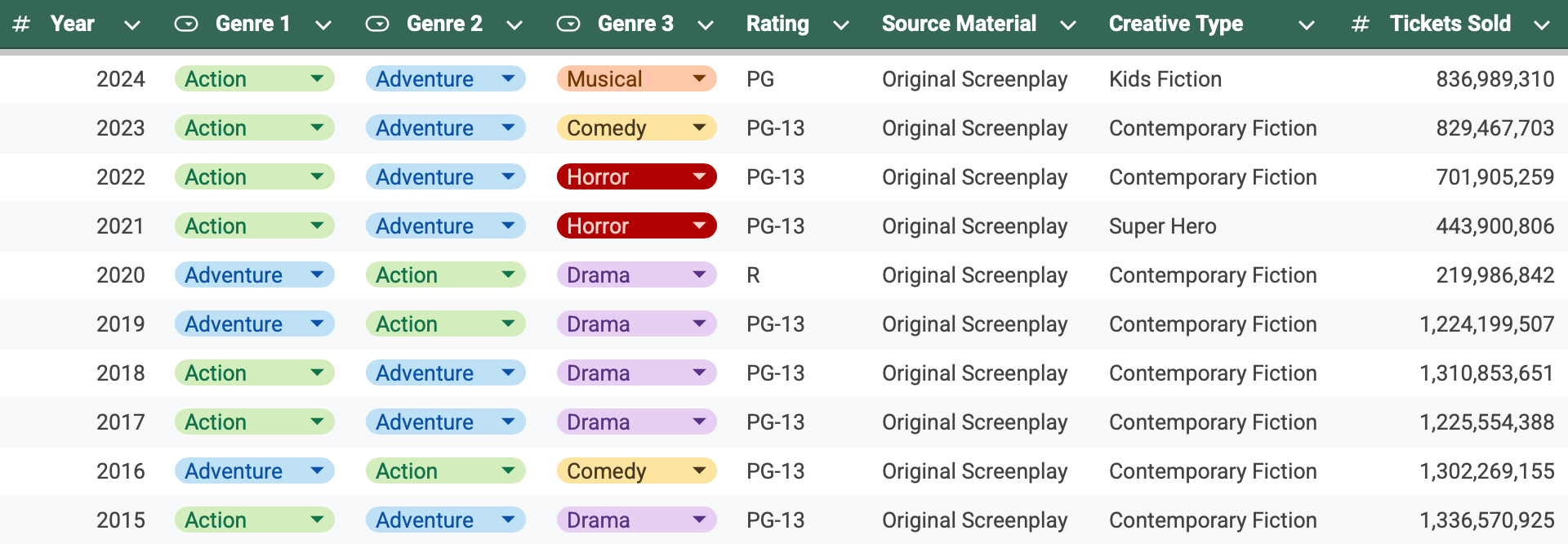How to PROFITABLY Invest In Indie Film
There are proven business principles that, remarkably, the film industry seems uniquely skilled at ignoring.
Indie films are the worst culprits.
I can't think of another industry that would ever invest $1,000,000 into creating a project, without having a plan for how to go to market.
Yet, this happens more often than not. The reason is simple - the people making the films are creatives - they know how to make stuff! The marketing, sales, distribution, licensing, all that business stuff? That's someone else's job...
This is why so many investors won't ever come back to invest in another film, because they believe that every other experience will be just as frustrating.
Here's the surprising truth: creating a go-to-market plan isn't actually that difficult. As an example, let's take a quick look at the current demand in the marketplace for indie films over, say, the last 10 years:

In about an hour of searching (using sources like the-numbers.com and boxofficemojo.com), you can clearly see a few things:
- Most movie goers buy tickets to action and adventure movies
- That are PG-13 or lower
- They prefer original stories (rather than IP)
- Since the low point of 2020 (COVID) ticket sales have grown year over year
While not a full-on analysis by a huge consulting firm, you can see how a little bit of data can inform the decisions we make as filmmakers.
And yet...
In 2024, of all of the films released theatrically, 304 were rated R, 121 were rated PG-13, 67 were rated PG, and 2 were rated G. (Source)
Hollywood studios - who release 35% of the movies but represent over 80% of the box office - are the biggest culprit, but indies aren't far behind when it comes to the number of R-rated films being put into the marketplace, despite the demand.
The market is showing with their dollars that they want original, fictional stories, with genres like action, adventure, comedy, drama, and musicals, that are family friendly.
Principle #1 for producing profitable indie films is: meet the existing demand.
Marketing & Distribution - not "someone else's problem"
Principle #2 is to understand that marketing and distribution should be in place at the same time as you greenlight the movie. Not after the film has already been shot and edited.
Most indie films raise the money, immediately go into pre-production (skipping any further development on the script and story), and then production and post-production (editing, color, sound, VFX, music, etc)
Then the rude awakening happens: no one wants your movie.
No one wants to distribute it. No one wants to help you sell it. No one wants to buy a ticket to watch it, or spend the money to rent it.
If we keep this up, we won't have an indie film industry to work in!
Instead, we need to have the marketing team in place at the same time as the production team. Conversations with distributors need to happen concurrently with investors. The plan for marketing and distribution needs to be in place before the movie is filmed so that the audience will show up when the movie is released!
Oversubscribed? Impossible!
Most businesses outside of the film industry understand the importance of being oversubscribed - where there's more demand for a product than there is capacity.
- Apple has people lining up out the door the day a new iPhone is available
- The price of Bitcoin increases because there is limited supply
- There are only so many seats on a plane, or in a restaurant, or at a concert
Yet, we haven't implemented this principle in the film industry. In fact, we are ever-relying on the digital streaming model popularized by Netflix to the demise of supply and demand tension that we had with DVDs years ago:
If there is unlimited supply, you'll never be oversubscribed.
Principle #3 is that only businesses that are oversubscribed can be profitable. So we have to manually create supply and demand tension, or else we will go the way of the music industry, where it's extremely hard to make any money from your music by selling it directly to your audience on streaming platforms.
Filmmakers tell me all the time that it's not possible, because the studios/streamers/theater circuits say so. Poppycock!
There are dozens of new platforms and hybrid distribution models that allow indie filmmakers to become oversubscribed. There's no excuse anymore, we just have to choose to follow proven business principles rather than what "the industry" says you can and can't do.
Part of being independent is being non-dependent on the larger Hollywood/Studio/Streamer ecosystem, and own the entire value chain.
Development > Financing > Production > Marketing > Distribution & Sales
Any time we abdicate the responsibility for any part of the process, we give up control, ownership, and upside.
Which makes it that less likely the investors will see a return on their investment.
So we have (at least) three obstacles:
- A focus on supply-side selling - creating what we want and hoping the market likes it
- No plan for marketing and distribution because...it's hard? ¯\_(ツ)_/¯
- The current ecosystem is set up (by the studios and streamers) to prevent becoming oversubscribed
But we also have proven solutions to these problems:
- Shift to demand-side selling. Feed the demand of the growing marketplace.
- Marketing and distribution plans from the start
- Become truly independent and oversubscribed by owning the value chain and selling directly to your audience
Simple? Kind of. Easy? Heck no! But that's what's so fun about it. Because when you own the whole value chain, you also own all of the upside...
Speaking of which...keep reading...